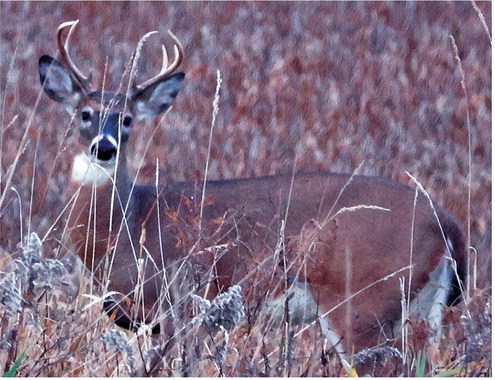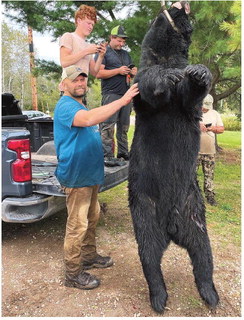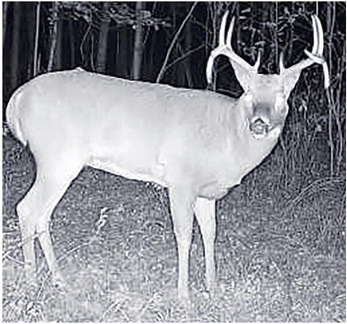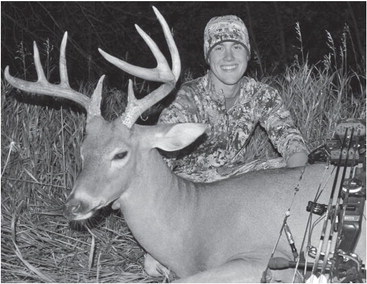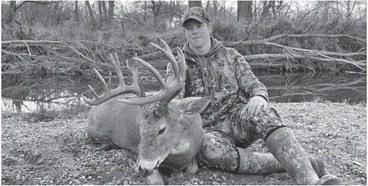Harvest rates picking up in state after a slow, warm start to the fall
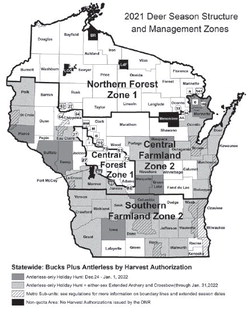

BY MATT FREY
THE STAR NEWS
November has arrived in Wisconsin and so has November- like weather after what had been a relatively mild September and October.
Combine the cooler temperatures with the peak of the rut and it definitely feels like deer hunting season once again in Wisconsin.
Many state hunters have already added venison to the freezer or placed orders at their taxidermists this fall following successful bow or youth hunts. Next week, the focus turns to the nine-day firearms hunt, set for Nov. 20-28. How deer populations sit will depend on where you hunt.
But generally speaking, deer herds in northern and central Wisconsin are strong and those who do their homework will have chances to see and harvest deer, especially if the fickle late fall weather cooperates.
“Agricultural crop harvest is on or ahead of schedule. That’s a good thing,” said Jeff Pritzl, the deer program specialist for the Department of Natural Resources in a Nov. 3 briefing with statewide media. “The more corn that’s off the landscape on the farmland usually leads to better hunting opportunities. Water levels are average to being on the drier side so right now we don’t have high water or flooding issues that could impair access. If we look at the current harvest that’s happening in the archery and crossbow season, right now our buck harvest is running at or ahead of the five-year average in all four of the deer management zones. So that trend usually carries through into the gun season. That’s a good omen as well.”
Through October, harvest numbers in the fourcounty Central Wisconsin News coverage area were down a bit from last year’s pace, but the daily harvest numbers reported on the Department of Natural Resources’ website have picked up in the last week to 10 days, which isn’t surprising, given that early November should be prime time.
“Things seem overall on par,” said Emma Doden, the DNR wildlife biologist for Taylor and Rusk counties, on Oct. 28. “The harvest so far for archery, crossbow and the youth season is down maybe a little bit from the last couple of years’ harvests, but I think that may be just because of the warm temperatures. Now with this last weekend (Oct. 22-24), we’ve had that shift finally and I think we’ll definitely see things pick back up again.”
“What we saw this year so far from mid-September to mid-October is the harvest was trailing the five-year average and we can speculate that conditions were warm and pretty mosquitoey at the beginning of the season,” Pritzl said. “Literally in the last two weeks, as we have gotten more fall-like weather and better conditions, we’ve made up for that in the buck harvest and we’ve caught up. In some cases we’ve surpassed the five-year average on the buck harvest side in just the past two weeks.”
DNR wildlife management program director Eric Lobner anticipated high participation statewide in this year’s hunt. Last year, there were about 876,000 deer-hunting licenses sold covering all of the seasons and included buyers from all 50 states and 14 different countries.
See HUNT OUTLOOK on page 4 Hunt outlook
Continued from page 1
“We will sell right around 220,000 licenses in that week prior to the nine-day gun deer season,” Lobner said. “This is the time for hunters to get out there, purchase their licenses and don’t wait to the last minute. They certainly can, our system is fantastic and it’s been doing excellent the last number of years. But certainly you don’t want to risk any sort of glitch in the system.
Here is a forecast synopsis for the four-county Central Wisconsin News coverage area.
Taylor County
Some of the most noticeable changes this fall are taking place in Taylor County, which was hit with its first case of chronic wasting disease. Baiting, a big part of the hunting culture in the county, is no longer legal.
“I think it’ll certainly affect deer behavior,” Doden said, adding that deer drives may be a more effective way this season to get deer moving. “They’re probably going to revert to more natural movement. Some hunters might have to change tactics a little bit from what’s been done in the past. I think this is a good opportunity for people to get reacquainted with the normal ecology and behavior of deer. They may have to spend more time out there and try to just learn more about their natural movements, what paths they’re taking and the timing of everything. It’s going to be a little less predictable than them coming into a bait pile.”
Like most areas of the north, Taylor County’s harvest numbers in 2020 bounced back after the 2019 nineday gun season experienced a drop with two in-season snowstorms and the latest start date possible being two blamed factors.
Gun season registrations for buck went up 5%, while the antlerless kill went up 39.2%. Covering all seasons, 6,168 deer were registered by county hunters in 2020, up 28.3% from the 4,807 registered in 2019.
In January, Taylor County’s Deer Advisory Council approved keeping the county in an increase objective for another three seasons, but that remains a public land focus. The council and DNR officials are hoping for a healthy harvest on private lands and the farming areas of southern Taylor County. In May, the council established an antlerless harvest quota of 3,100 deer for the county, breaking that down to 2,800 deer on private land and 300 on public land. Based on last year’s success rates, that led to 1,200 bonus antlerless authorizations being quickly sold for public land and 10,000 made available for private land, about 40% of which were still available last week.
“There are still over 4,000 private tags available for those antlerless bonus tags,” Doden said. “If folks have a chunk of private land or access, I encourage them to get an antlerless tag to give themselves a better chance of filling their freezer.”
Increased CWD surveillance is also something Taylor County hunters will notice. There are seven selftesting kiosks available throughout the county. Hunters are also strongly encouraged to dispose of their carcasses in dumpsters that are available in November at the Medford DNR Ranger Station and the Rib Lake Cenex station.
“We have that monitoring ramped up this year just because we really want to just be as cautious as we can with this disease,” Doden said. “It can be highly transmissible once it gets out there. It lasts a long time in the environment and once a deer gets it, it’s 100% fatal. Prevention is really the key with CWD if we can keep it out of the wild population.”
Through Nov. 2, crossbow and archery hunters in the county were well behind 2020’s pace with 548 filled crossbow tags, including 316 bucks, and 213 archery tags filled, 124 of which were bucks.
Doden encouraged Taylor County hunters to be involved in the deer management process by following the actions of the County Deer Advisory Council and filling out the DNR’s Deer Hunter Wildlife Survey (https:// dnr.wisconsin.gov/topic/WildlifeHabitat/wlsurvey. html).
Marathon County
For the third hunting season in a row, those serving on the County Deer Advisory Council in the state’s largest county, Marathon County, set an antlerless harvest quota of 7,000 deer for this fall and are urging hunters to be willing to harvest some of those deer in order to meet the county’s “maintain” three-year objective.
Marathon County is a Central Farmland Zone. As in recent seasons, one free farmland authorization went to every license buyer who wanted one this fall in Marathon County, which is how the vast majority of antlerless permits are issued in the county. In fact, a record 36,812 such tags were issued last year with 13.6% of them (5,019) being filled.
Just like the past two years, an additional 2,000 private- land tags were made available for purchase. As of Nov. 3, just 61 of them were still available. The county again offered no bonus public-land authorizations this year, but does can be shot on public lands using the farmland tags. The county features about 50,000 acres of accessible land, with the nine units of the Marathon County Forest, the McMillan Marsh Wildlife Area and the Mead Wildlife Area being the largest public properties.
Marathon County’s DNR wildlife biologist Brandon Stefanski noted during the quota-setting process in the spring that a harvest of 7,000 antlerless deer isn’t likely to stop the herd from increasing in this heavily-agricultural county. It’s a goal that won’t be easy to reach but is one to shoot for.
In 2020, county hunters registered an overall total of 11,607 deer, which was up 16.7% from 2019’s disappointing total of 9,950. The total included 6,254 antlerless deer, well short of the 7,000 quota, but also a 19.8% increase over 2019. Harvests were up from 2019 in all seasons in Marathon County.
The vast majority of deer in the county are taken on private lands –– 10,305 of them last fall.
Discussions over the past year resulted in a proposal to split the county into two deer management units starting 2022. The plan to create a second unit in the county’s southeast corner with a decrease population objective was passed by the Deer Advisory Council in January.
While there is a focus on does, there, of course, are still plenty of bucks to be had in the county. Through Nov. 2, DNR statistics showed crossbow hunters registering 670 bucks and 478 does, down from 791 and 723 at the same time last year, while archery hunters had tagged 359 bucks and 279 does, down from 466 and 479 a year ago.
Clark County
In another of the state’s largest counties, Clark County, there are expectations for another solid gun deer hunt in 2021 with populations generally believed to be on the rise, especially after the mild winter of 2020-21 that should have had little to no impact on the county’s deer herd.
Being a large county, Clark County does have diversity in land types, meaning some areas will hold more deer than others.
The county is divided into two deer management zones. Most of the land is in the Central Farmland zone, which is operated by the Clark County Deer Advisory Council under a maintain population objective. Roughly the southern third is in the Central Forest Zone, including the 135,000-acre Clark County Forest. This land is under an increase population objective.
In the spring, the county’s Deer Advisory Council set quota and antlerless authorization levels aimed at an aggressive harvest it views as needed to follow the maintain objective in the Farmland Zone. The quota was increased from 4,000 last year to 5,700 this year and hunters were offered two farmland zone tags per license purchased, up from one a year ago. Plus 2,050 bonus tags were put up for sale to private-land hunters. As of Nov. 3, 1,223 of those tags were still available.
The total harvest in the Central Farmland Zone of Clark County shot up about 16% last fall. Like just about all areas in the state, the nine-day gun season went much better than it did in 2019 with a 17% increase in the buck kill to 2,099 registered deer and a 9.4% antlerless increase to 3,290 registered deer for a total of 5,389. That compared to 4,800 total deer registered in the 2019 nine-day season.
Crossbow and archery harvests also rose last year in farmland areas.
Concern remains for some regarding the population levels in the county’s Central Forest Zone. The antlerless quota was raised slightly from 500 to 700, reflecting the favorable conditions for herd growth. But the public antlerless authorization level remained the same at 700 and the private land tags went up from 1,700 to 2,000. Those tags have sold out.
The Central Forest’s 2020 harvest totals nudged upward slightly, 4.3% overall, from 2019 with 78 more deer registered.
Last fall, 16,276 farmland tags were issued for private lands with a success rate of 19.4% (3,150 filled). The success rate was 17% in 2019. Success rates were lower on public land farmland tags with only 10.2% of 4,190 tags being filled (426 deer). Antlerless authorization holders in the Central Forest Zone are more likely to use them. Last year’s overall success rate on those tags was 25.3%, up from 21.4% in 2019. A total of 608 antlerless deer registered in the zone, 157 on public land and 451 on private land.
Through Nov. 2, according to DNR statistics, hunters had registered 874 deer by crossbow and 420 deer by archery in the Farmland Zone of Clark County and an additional 236 deer by crossbow and 121 deer by archery in the Central Forest Zone.
Those figures are down about 20% compared to last year at this time.
Chippewa County
Maintaining the deer herd is the objective in Chippewa County’s Central Farmland and Northern Forest zones and that’s what the county’s Deer Advisory Council is set on doing.
The council first sent what it termed “a strong statement to the public that we need to harvest additional antlerless deer in the county” when it offered 10,000 private-land antlerless authorizations in the Farmland Zone and 3,500 more private-land authorizations in the Forest Zone in its preliminary meeting in March.
The council backed off on those numbers when it reconvened in May, realizing there’s no way all of those bonus authorizations would be sold. Still, the message was clear from the council and the county’s DNR wildlife liaison Jess Carstens that there is a need to keep deer numbers in check in some areas of the county.
In the Farmland Zone, which encompasses roughly the southern two-thirds of Chippewa County, the council settled on a 2021 antlerless harvest quota of 5,000 deer and offered one free farmland tag per license bought by hunters as well as 3,500 private-land tags and 300 publicland tags that could be purchased for $12 apiece.
As of Nov. 3, 2,519 of the private-land and 138 of the public-land tags were still available.
The Central Farmland portion of the county experienced a solid harvest in 2020, possibly indicating a slower 2019 nine-day gun hunt was a bit of a fluke due to weather conditions and the latest possible start to the season. The buck kill went up 11.7% during the gun hunt, while the antlerless take was up almost 24%. Crossbow harvests continued to spike, with an antlerless rise of 63% over 2019 and a nearly 38% hike in buck harvests. Even the dwindling number of archery hunters still had more success in 2020 than they did in 2019.
The mild winter and comfortable spring should have done nothing to slow the herd from adding on during the spring and summer months.
So far, harvests have been higher in 2021 in the farmland areas than they were in 2020. As of Nov. 2, 496 deer had been take by crossbow hunters, including 294 bucks and 202 antlerless deer. Archers had nabbed 284 more, including 131 antlerless deer.
In the Northern Forest Zone, which generally covers land north and east of Hwys 64 and 53, the antlerless quota is a modest 1,000 deer this year. There were 375 public-land doe tags made available and those were quickly snatched up. As of Nov. 2, 2,236 of the 3,625 private- land tags were still available. A total of 1,414 deer were harvested overall in the forest zone in 2020, up 52.7% from 2019’s total of 926. The antlerless kill shot up 123% from 2019, going to 636 deer, while 778 of the total were antlered bucks.
Through Nov. 2, crossbow hunters had taken 150 deer in the zone, including 98 bucks, and archers had harvested 91 deer, with 56 of them being bucks.
Chippewa County also has a metro unit surround-
See CHIPPEWA on page 14 Chippewa County
Continued from page 4
ing the Chippewa Falls area. Hunters were offered two metro antlerless authorizations per license for that subunit while 900 private-land bonus tags and 100 more public-land tags were offered. Plenty of those tags are still available.
There were 15,033 farmland tags issued last year in Chippewa County and 1,982 of them were filled (13.2%). Private land users were far more successful than private land users (14.7% to 6.6%). There were an additional 2,350 bonus authorizations sold and more hunters got their money’s worth out of those with a 21.6% success rate.
While bonus tags were obviously not as plentiful in the Forest Zone, 25.6% (534) of the 2,088 issued tags were filled. The Northern Forest split in Chippewa County was first used in 2018 to better manage the herd on this more wooded part of the county.
